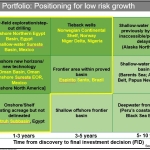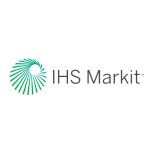IHS Markit Identifies Five Billion Barrels of Oil Equivalent in ’Short-Cycle’ Opportunities Outside North America
Late basin-life discoveries provide operators a source of free cash
flow and capital flexibility in a low-cost path to production
HOUSTON–(BUSINESS WIRE)–New energy research from business information provider IHS
Markit (Nasdaq: INFO) has identified more than five billion barrels
of oil equivalent (BOE) in numerous smaller, previously bypassed, or
underperforming reservoirs outside North America that offer oil and gas
operators a ’shorter-cycle’ path to production than new, frontier
projects in undeveloped areas.
The IHS Markit report, entitled: “Back to the Basins: International
Shorter-Cycle Opportunities,” initially assessed five, short-cycle
projects outside the U.S. in mature, late-life basins in Mexico,
Nigeria, Egypt, Brazil and the North Sea, and included both shallow
water and mature, onshore areas that break even at per-barrel costs
under U.S. $40.
“These five case studies represent just a fraction of the opportunity
that we identified globally,” said Kareemah
Mohamed, associate director, Plays and Basins research at IHS
Markit, and author of the analysis entitled “IHS Markit Back to the
Basins: International Shorter-Cycle Opportunities.” “Stagnant
oil prices continue to limit large-scale investments in global
exploration worldwide, including deepwater plays, and many onshore U.S.
projects are not yet cash-flow positive, so energy investors are
demanding financial returns,” she said. “These investors want to see
companies demonstrate greater capital discipline and growth while living
within their cash flow. The focus has moved away from simply reserves
capture, to production growth, and now to value maximization. In this
environment, reduced tolerance for exploration risk persists.”
Cognizant of this “new normal” E&P environment, Mohamed said she
embarked on a study that assessed mature, producing basins with a goal
of helping operators identify less capital-intensive, shorter cycle-time
projects. Projects, Mohamed said, that would enable operators to reduce
risk by leveraging both existing basin infrastructure and their unique
capabilities in plays outside the U.S. and Canada.
IHS Markit defines shorter-cycle projects as those that can generate
first cash within one to two years of development, or, in the case of
new entrants, projects that progress to final investment decision (FID)
in less than three years. The typical deep-water project averages seven
years to reach FID with exponentially more upfront investment.
The key screening criteria to identify these targets and minimize
investment risk, Mohamed said, were shallow-water shelf areas and
onshore mature fields—basins with a proven hydrocarbon system. In
addition, these areas had to have existing production and infrastructure
(wells [and associated production and well data], pipelines, platforms
and gas plants) in place.
With these basins identified, the next step was to look at a combination
of above ground and sub-surface risks to pinpoint avenues for new-basin
entry. Mohamed identified such opportunities that could allow for
incremental added production volumes, but also provide a source of free
cash flow to the operator.
“Due to the changing investor sentiment toward value maximization and a
reduced tolerance for risk, as well as the nature of these shorter-cycle
projects in mature basins, it was essential to advance the research
approach from one of a project-by-project basis to a whole-basin
strategy,” said Jerry Kepes, executive director for Plays and Basins
research at IHS Markit. “We’ve observed that the best results occur when
operators target basins with materiality and two or more working
petroleum systems, stacked reservoirs, existing infrastructure,
service-sector capacity and technical knowledge.”
Mindful of these market dynamics, Kepes said he and his IHS Markit
researchers see this shift to whole-basin strategies as being critical
to operators achieving competitive performance, representing a
fundamental shift in the approach to analysis and company strategies
going forward.
“Whole-basin strategies can include ‘field growth’ where the focus is on
targeting new barrels in old fields, but can also include upfront, new
ventures work that targets shorter-cycle barrels in under-explored areas
in existing commercial basins,” Kepes said. “Some of those mature basins
present fresh opportunities for operators because an E&P opening makes
new acreage available.”
Mohamed’s research included case studies on Oman and the Egyptian
offshore Western Desert, but she also identified basins that were
previously off-limits due to political instability, or those previously
overlooked because of single operator (typically state-owned) access,
stringent regulatory terms, or bureaucratic barriers, but now offer more
favorable terms and are open to foreign investment. Additional examples
of shorter-cycle development opportunities now available include basins
in Mexico.
Eni’s new entry into Mexico’s mature, shallow-water Sureste Basin is one
example. The Area 1 discovery (1.4 billion BOE) was made in an
underexplored area of the Sureste Basin, with first oil targeted for
2019, just two years after discovery. Through leveraging existing basin
infrastructure, the project’s expected break-even cost should be below
U.S. $40 per barrel, according to IHS Markit *(Source: IHS Vantage).
“This new-ventures screening alternative provides targets that offer
operators a lower-cost path to free cash-flow in a shorter period, but
also the potential for repeatable investment opportunities over time,”
Mohamed said. “In the current economic environment, this makes the
short-cycle opportunities very intriguing to operators, so we are
currently expanding the initial research to include more basins.”
To speak with Kareemah Mohamed or Jerry Kepes, please contact Melissa
Manning at [email protected].
For more information on the analysis entitled, “IHS Markit Back to
the Basins: International Short-Cycle Opportunities,” please contact [email protected].
About IHS Markit (www.ihsmarkit.com)
IHS Markit (Nasdaq: INFO) is a world leader in critical information,
analytics and solutions for the major industries and markets that drive
economies worldwide. The company delivers next-generation information,
analytics and solutions to customers in business, finance and
government, improving their operational efficiency and providing deep
insights that lead to well-informed, confident decisions. IHS Markit has
more than 50,000 business and government customers, including 80 percent
of the Fortune Global 500 and the world’s leading financial
institutions. Headquartered in London, IHS Markit is committed to
sustainable, profitable growth.
IHS Markit is a registered trademark of IHS Markit Ltd. and/or its
affiliates. All other company and product names may be trademarks of
their respective owners © 2018 IHS Markit Ltd. All rights reserved.
Contacts
IHS Markit
Melissa Manning, +1 713-906-2901
[email protected]
or
Press
Team, +1 303-305-8021
[email protected]
Follow
@IHS_News
.jpg)








